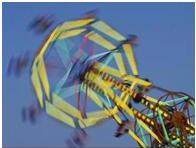Vestibular Dysfunction

Learn how to identify symptoms of vestibular dysfunction in a child with sensory processing disorder. Stimulation from this sense comes from the tiny hair cells in the inner ear that register every change in head position as related to balance and movement.
Auditory dysfunction often occurs as well, due to both being perceived within the system of the ear. You may find that some children with this either passionately love or hate amusement park rides. The symptoms related to the vestibular sense may seem similar to signs-symptoms of autism because it can often cause a delay in toddler speech development.
It’s amazing that something so small can detect even the slightest bit of movement we make. In fact, all sensations are interpreted with reference to the vestibular system. The nervous system depends on this working properly in order to process sensory input from all of our senses. If there is vestibular dysfunction, then all other aspects of the nervous system will fail to function accurately as well.
Signs of vestibular dysfunction include sensory seeking behavior, and/or hyper/hypo sensitivity to movement..
A. Vestibular Disorder with Hypersensitivity to Movement:
• Dysfunction causes resistance to moving playground equipment, such as swings, slides or merry-go-rounds
• Desires stationary tasks and moves slowly and cautiously
• Fear of heights and falling
• Easily lose balance or referred to as a “klutz”
• Avoidance of stairs, elevators, and escalators
• Demand physical support from an adult
• Lack of motivation to actively move
• Swing for long periods of time without getting dizzy
• Unaware of sensation of falling and failing to protect him/herself by extending hands or feet to catch him/herself
• Loves amusement park rides
• Described as hyperactive – always running, jumping, and hopping
• Engages in rocking or rhythmic movements
• Trouble sitting still or staying seated
• May vigorously shake head or rock rhythmically
• Crave intense movement including jumping, upside-down positions
• Enjoy swinging very high
• Loves seesaws, teeter totters or trampolines more than other children
• Can’t seem to sit still
• Likes spinning in circles
• Limp or floppy body
• Often “W sits” when on the floor
• May have skipped crawling as an infant
• Weak gross motor and fine motor skills
• May seem to be ambidextrous, by often switching hand use
• Struggles to mimic dance moves and exercises
SPD Treatment of Vestibular Dysfunction
Treatment of sensory processing disorder is usually determined by an occupational therapist. The therapist would do an evaluation of the specific needs of your child then develop occupational therapy goals. If it is determined that the vestibular sense is mainly affected, then treatment is based on this determination.
Because our son primarily had sensory seeking vestibular dysfunction, his treatment has included therapeutic listening with a sensory diet and the wilbarger brushing protocol. As a result we have noticed immense improvements in his language, ability to transition to another activity, and sit still to focus on a task.
Additional Recommended Pages:
• Auditory Processing Disorder
• Proprioceptive Input
• Tactile Concerns
• Tactile Defensiveness with hypersensitivity to tactile stimuli
• Oral Defensiveness
• Olfactory Dysfunction
References
1. Sensory Processing Disorders. Sensory Processing Disorder Checklist.www.sensory-processing-disorders.com. 1-16-10.
2. Kranowitz, C. S. (2005). The Out-of-Sync Child: Recognizing and Coping with Sensory Processing Disorders. New York, NY: Penguin Group.